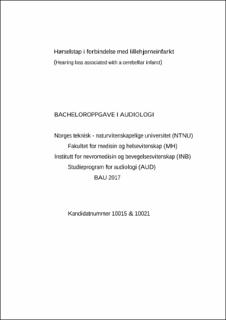| dc.contributor.advisor | Lindseth, Marte Kristine | |
| dc.contributor.author | Eik Myrvold, Helen | |
| dc.contributor.author | Engen, Marianne | |
| dc.date.accessioned | 2020-06-20T16:00:35Z | |
| dc.date.available | 2020-06-20T16:00:35Z | |
| dc.date.issued | 2020 | |
| dc.identifier.uri | https://hdl.handle.net/11250/2658907 | |
| dc.description.abstract | I denne bacheloroppgaven har vi valgt temaet lillehjerneinfarkt og plutselig hørselstap. Med dette som utgangspunkt har vi valgt følgende problemstilling:
Kan audiologiske målemetoder oppdage lillehjerneinfarkt i forbindelse med plutselig hørselstap og hvilke konsekvenser kan dette infarktet ha for hørselsfunksjonen?
Vi har sett på hvilke audiologiske målemetoder som ble utført for å definere plutselig hørselstap i forbindelse med infarkt i lillehjernen. I tillegg ville vi finne ut om det vises på målingene at deltakerne har hatt hjerneinfarkt. Oppgaven er basert på en litteraturstudie med 10 artikler som har benyttet kvantitative metode. Testene som er benyttet i studiene er rentone-og taleaudiometri, stapedius refleks, hjernestammeresponsaudiometri (ABR), vestibulær fremkalte myogent potensiale (VEMP) og kalorisk test.
Resultat fra artiklene viser at deltakerne hadde hørselssvekkelse lokalisert både i cochlea, retrocochleært eller en kombinasjon av disse. Noen deltakere hadde ukjent lokalisasjon på skaden. Basert på disse studiene viser de audiologiske målingene at et lillehjerneinfarkt kan medføre alt fra plutselig mildt hørselstap til døvhet, avhengig av hvor blokkeringen er lokalisert. Studiene viser til at hørselen kan normaliseres etter behandling. Studiene viser også at alder ikke er en faktor som har stor betydning for hvem som er utsatt for lillehjerneinfarkt, mens høyt blodtrykk, høyt kolesterol, røyking og diabetes kan øke risikoen.
Vår konklusjon er at audiologiske metoder alene ikke kan oppdage at et lillehjerneinfarkt er årsaken til et plutselig hørselstap. Imidlertid gir metodene gode indikasjoner på at noe er skadet i hørselssystemet og kan gi oss en pekepinne på hvor skaden kan være. Ytterligere tester, for eksempel magnetresonanstomografi (MRI), må utføres for sikkert å kunne påvise hjerneinfarkt.
Nøkkelord fra oppgaven er lillehjerneinfarkt, iskemisk infarkt, plutselig sensorineuralt hørselstap og audiologiske målemetoder. | |
| dc.description.abstract | In this bachelor thesis we have focused on the theme cerebellar infarct and sudden hearing loss. Based on this, we have chosen following research question:
Can audiological measurement methods detect cerebellar infarction in connection with sudden hearing loss and what consequences do the infarct have for the hearing function?
We have looked at the audiological measurement methods that were performed to define sudden hearing loss associated with cerebellar infarction. The thesis is based on a literature study with 10 articles that have used a quantitative method. The tests used in the studies are pure tone - and speech audiometry, acoustic reflex, auditory brainstem response (ABR), vestibular evoked myogenic potential (VEMP) and caloric test.
Results from the articles show that the participants had hearing impairment located either in the cochlea, retrocochlear or a combination of these. Some participants had unknown location of the injury. Based on these studies, the audiological measurements show that a cerebellar infarct can cause anything from sudden mild hearing loss to deafness, depends on where the occlusion is located. The studies also show that age is not a factor that is of great importance, to who is prone to cerebellar infarction, while high blood pressure, high cholesterol, smoking and diabetes can be risk factors.
Our conclusion is that pure audiological methods alone cannot detect cerebellar infarction associated with sudden hearing loss. However, the methods give good indications that something is wrong. Further tests, such as Magnetic resonance imaging (MRI), must be performed to be able to safely detect a cerebellar infarction.
Keywords from the thesis are cerebellar infarction, ischemic infarction, sudden sensorineural hearing loss and audiological measurement methods. | |
| dc.publisher | NTNU | |
| dc.title | Hørselstap i forbindelse med lillehjerneinfarkt | |
| dc.type | Bachelor thesis | |
